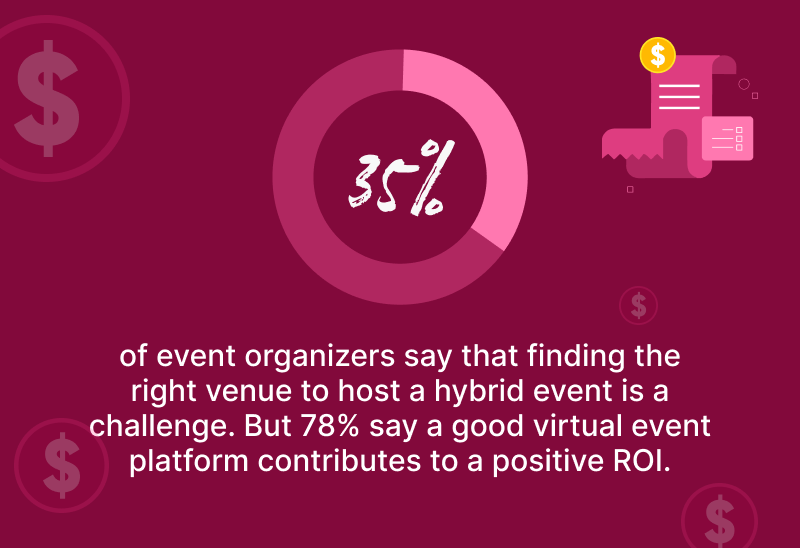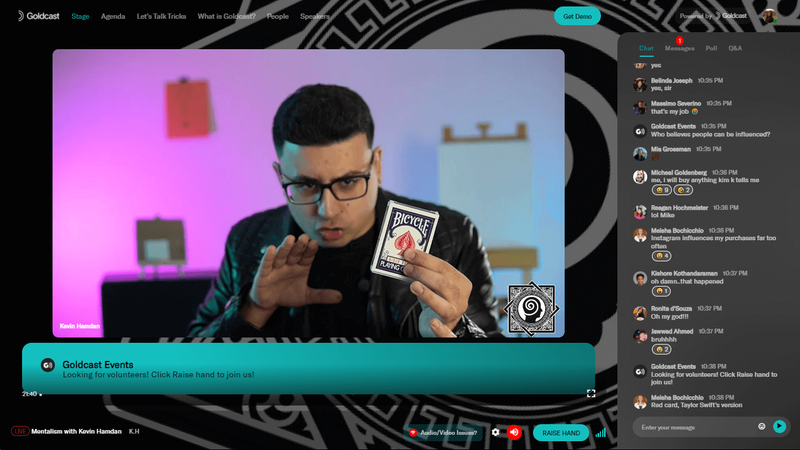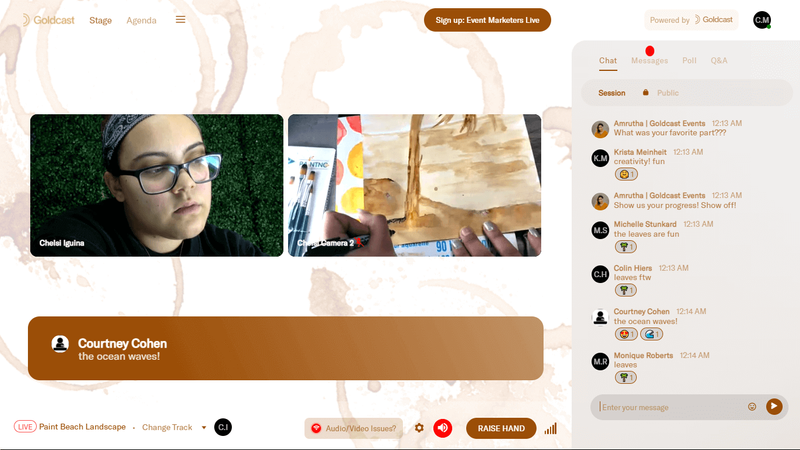Building a Hybrid Event Budget that Won’t Break the Bank [Plus Free Template]

Table of Contents
Maximize Your Marketing ROI
Join 10,000 other marketers already getting the best tips on running engaging events that boost pipeline and create raving fans.
If you’ve been in the event marketing game for long, you can probably set a budget for in-person events with your eyes closed. Not only that, you’ve likely learned the ins and outs of virtual event budgeting too.
And, now? Well, now you’re expected to create a whole new type of event budget to deliver the best of both worlds.
That’s right, it’s time to plan your budget for your next (or possibly, first) hybrid event.
At first, hybrid events can seem anything but straightforward. But this new event format isn’t going anywhere anytime soon.
To get a firm grip on hybrid event planning, you’re going to need to get to the root of key budgeting questions like:
- What should a hybrid event budget include?
- How can I create a hybrid event budget from scratch?
- And how much does a hybrid event actually cost?
Let’s tackle these questions one by one to make sure your next hybrid event gets you the approval and return on investment (ROI) needed for a long and successful future with hybrid.
Here’s what we’ll cover
- What is a hybrid event? And why it’s worth the money
- The six core hybrid event cost centers to consider
- (In-person budget + virtual budget) * 1.25 = Hybrid event budget
👋 Check out our handy (and totally free!) Virtual Event Budget Template as a starting point to nail your event planning. You can download this Excel or copy this Google Sheet. Enjoy!
What is a hybrid event? And why it’s worth the money 💰
Hybrid events are exactly what they sound like: one part virtual, one part in-person.
And with 86% of B2B organizations reporting a positive ROI on hybrid events seven months after the event date, the value case for hybrid is clear.
Here are a few of the other big benefits hybrid events can offer event professionals:
- Increased attendee numbers
- Greater access to global leads
- Broader topic coverage
- Multiple tracks and viewing options
- Amplified engagement features
- Deep attendee-level data
- Reduced carbon footprint
With perks like this, you’re probably itching to get started planning your hybrid event — beginning with a healthy, ROI-friendly budget.

Source: Markletic
Planning your hybrid event budget: The six core cost centers to consider
If you’re like many event planners and managers dipping their toes into the water with hybrid events, you might be thinking:
“Hybrid…double the events, double the costs, and double the budget.” 🤯
But bear with us. If you can lock down your core hybrid event line items early, you’ve already done the heavy lifting — and the rewards will be well worth the effort.
Let’s take a closer look at the top six cost areas for hybrid events.
1. In-person venue + virtual event platform
While we’re all excited to get back to firm handshakes and face-to-face conversations, returning to in-person events also means bringing back the hefty venue costs that come with them.
The cost of a physical event venue can range from:
- Totally free for in-house conferences.
- $100-$250 per hour for smaller, local venues (think: WorkBar).
- To $1,250+ per hour for large-scale event venues.
Keep in mind, there are a lot of other costs to consider for your in-person event venue aside from just the physical space. Be sure to factor in things like food and beverage expenses, audio-visual support, event signage, branding, etc.
And then there’s the virtual venue, a.k.a. your event platform.
This is a great place to kick off the planning for your hybrid event budget because, like any venue, this is one area where you just can’t afford to cut corners.
As with a physical venue, the cost of hybrid event platforms can vary greatly. Bare bones platforms will cost a few hundred bucks, while more robust solutions that provide optimal ‘wow’ factor can run well over $25,000. It all depends on the scale of your event and the experience you want to provide.
No matter how you cut it, this is likely to be one of the bigger expenses in your budget. You want to be sure you get maximum value for money.
Here’s a quick roundup of some of the top hybrid event platform features to look for:
- Live streaming to showcase remote speakers, common chat feeds, slide decks, and more.
- Multiple engagement levers to interact with both in-person and virtual audiences.
- Mobile accessibility to view agenda, engage via polls and Q&A, and network seamlessly, whether in-person or virtual.
- The ability for both in-person and virtual attendees to ask questions and network one-on-one.
- Ability to connect as many hybrid streams as needed and mix and match between sessions for ultimate flexibility.
- Virtual event production tools that support pre-recorded videos, buffer videos, RTMP live streaming, and more.
- Easy setup so that anyone with a laptop can attend!

Source: Markletic.
2. Speakers + entertainment
Live or pre-recorded, virtual or in-person — every event needs stellar speakers and sessions.
But the price here can definitely vary.
Speaker fees can range from just a couple hundred dollars (or even free!) all the way up to $100,000 or more. And while there are some excellent solutions for how to make your event more engaging, the extra swag, tasting, or cocktail kits will all come at a price.

If you’re looking to keep costs down at your next hybrid event, consider using some of your internal experts to bring these roles in-house, or negotiate with speakers to save money on a virtual session.
But if you have the budget to spare, why not go for the wow factor?
Book a band, a big-name speaker, or a super-refined sommelier masterclass with bottles of wine sent to each virtual attendee. 🍷
3. Hybrid event staffing
Hybrid events need two rockstar teams: one virtual, and one in-person.
While some of your hybrid event roles will inherently cover both areas (marketing, content, design, etc.), other areas may require you to double up on staffing (moderators, tech and sales).
Can’t stretch for more staff?
Take a tip from event pro Lisa Gregory. Lisa’s sandwich approach to hybrid helps you leverage your team across both the in-person and virtual components of your event.
Instead of running virtual and in-person events concurrently, you host your in-person event first and then host a virtual event using the in-person content plus a unique virtual offering.
💡For more top tips on how to win with hybrid events, be sure to watch our deep dive chat on Making Hybrid Happen with event marketing expert Lisa Gregory.
4. Branding
By now, you know the drill with printed material. For the in-person banners, podium signs and programs, you’re looking at around $130 an item.
The good news?
If you’re expecting a lower in-person head count at your hybrid event, you can have your event branding cake and eat it too.

That’s because virtual event branding is so much more affordable than the classic, not-so-environmentally-friendly printed option. Just be sure to use a platform that comes with built-in customization options so that you can build epic brand awareness at virtually no extra cost. 🤩
5. Hybrid event content production
Getting in-person and virtual speakers wired up with the right tech, producing pre-recorded and on-demand videos, and creating engaging decks to run alongside live event speakers — it’s all content.
And it all requires work.
Whether you have an in-house production team or you’re outsourcing the job, you don’t want to leave this piece out of your hybrid event budget.
So, how much are we talking?
According to estimates like this one from full-service video production company RaffertyWeiss Media, presenter coaching and recording can cost roughly $85-$95 per hour, while a multi-day virtual event managed by a production company can reach up to $50K or more.
One tip for protecting this area of your hybrid event budget is to seek out an event platform with built-in video production capabilities.
6. The extras: catering, swag, and more! 😎
While not essential, in-person events tend to come with a few extra expectations — namely, some yummy onsite meals and a branded swag bag to send home with attendees.
Averaging between $20-$40 per attendee just for lunch and around $8 per swag item, these are some added bonuses worth considering if you want your hybrid event to be one for the books.
And while it’s always awesome to mail these treats out to your virtual attendees, make sure you account for those extra shipping costs in your budget.
(In-person budget + virtual budget) * 1.25 = Hybrid event budget
When planning a healthy hybrid event budget, you’re going to need to get creative — both with how you engage your audience and how to do that without breaking the bank.
Because while the attendee experience is a joint one, everything else about a hybrid event remains pretty distinct. In many ways, it’s a whole new world for modern event marketers.
But as with any blank canvas, the best way to start is to simply put paint to paper.
Look for ways to leverage your content, creativity, and team power across both your in-person and virtual events. Listen to your attendees, review the date, revise and repeat.
Before you know it, hybrid events will be just another part of your event strategy!

Stay In Touch
Platform
Resources
Company
Community
© 2025 Copyright Goldcast, Inc. All rights reserved.



 Upcoming Events
Upcoming Events Event Series
Event Series On-Demand Events
On-Demand Events

